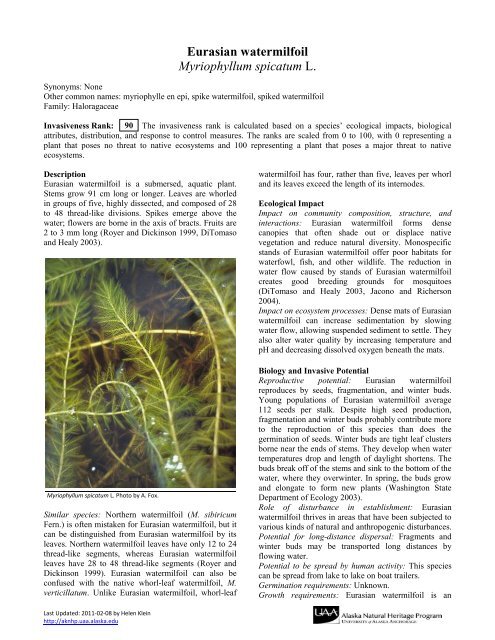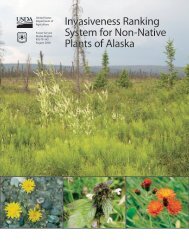Eurasian watermilfoil Myriophyllum spicatum L. - Alaska Natural ...
Eurasian watermilfoil Myriophyllum spicatum L. - Alaska Natural ...
Eurasian watermilfoil Myriophyllum spicatum L. - Alaska Natural ...
You also want an ePaper? Increase the reach of your titles
YUMPU automatically turns print PDFs into web optimized ePapers that Google loves.
<strong>Eurasian</strong> <strong>watermilfoil</strong><br />
<strong>Myriophyllum</strong> <strong>spicatum</strong> L.<br />
Synonyms: None<br />
Other common names: myriophylle en epi, spike <strong>watermilfoil</strong>, spiked <strong>watermilfoil</strong><br />
Family: Haloragaceae<br />
Invasiveness Rank: 90 The invasiveness rank is calculated based on a species’ ecological impacts, biological<br />
attributes, distribution, and response to control measures. The ranks are scaled from 0 to 100, with 0 representing a<br />
plant that poses no threat to native ecosystems and 100 representing a plant that poses a major threat to native<br />
ecosystems.<br />
Description<br />
<strong>Eurasian</strong> <strong>watermilfoil</strong> is a submersed, aquatic plant.<br />
Stems grow 91 cm long or longer. Leaves are whorled<br />
in groups of five, highly dissected, and composed of 28<br />
to 48 thread-like divisions. Spikes emerge above the<br />
water; flowers are borne in the axis of bracts. Fruits are<br />
2 to 3 mm long (Royer and Dickinson 1999, DiTomaso<br />
and Healy 2003).<br />
<strong>Myriophyllum</strong> <strong>spicatum</strong> L. Photo by A. Fox.<br />
Similar species: Northern <strong>watermilfoil</strong> (M. sibiricum<br />
Fern.) is often mistaken for <strong>Eurasian</strong> <strong>watermilfoil</strong>, but it<br />
can be distinguished from <strong>Eurasian</strong> <strong>watermilfoil</strong> by its<br />
leaves. Northern <strong>watermilfoil</strong> leaves have only 12 to 24<br />
thread-like segments, whereas <strong>Eurasian</strong> <strong>watermilfoil</strong><br />
leaves have 28 to 48 thread-like segments (Royer and<br />
Dickinson 1999). <strong>Eurasian</strong> <strong>watermilfoil</strong> can also be<br />
confused with the native whorl-leaf <strong>watermilfoil</strong>, M.<br />
verticillatum. Unlike <strong>Eurasian</strong> <strong>watermilfoil</strong>, whorl-leaf<br />
<strong>watermilfoil</strong> has four, rather than five, leaves per whorl<br />
and its leaves exceed the length of its internodes.<br />
Ecological Impact<br />
Impact on community composition, structure, and<br />
interactions: <strong>Eurasian</strong> <strong>watermilfoil</strong> forms dense<br />
canopies that often shade out or displace native<br />
vegetation and reduce natural diversity. Monospecific<br />
stands of <strong>Eurasian</strong> <strong>watermilfoil</strong> offer poor habitats for<br />
waterfowl, fish, and other wildlife. The reduction in<br />
water flow caused by stands of <strong>Eurasian</strong> <strong>watermilfoil</strong><br />
creates good breeding grounds for mosquitoes<br />
(DiTomaso and Healy 2003, Jacono and Richerson<br />
2004).<br />
Impact on ecosystem processes: Dense mats of <strong>Eurasian</strong><br />
<strong>watermilfoil</strong> can increase sedimentation by slowing<br />
water flow, allowing suspended sediment to settle. They<br />
also alter water quality by increasing temperature and<br />
pH and decreasing dissolved oxygen beneath the mats.<br />
Biology and Invasive Potential<br />
Reproductive potential: <strong>Eurasian</strong> <strong>watermilfoil</strong><br />
reproduces by seeds, fragmentation, and winter buds.<br />
Young populations of <strong>Eurasian</strong> <strong>watermilfoil</strong> average<br />
112 seeds per stalk. Despite high seed production,<br />
fragmentation and winter buds probably contribute more<br />
to the reproduction of this species than does the<br />
germination of seeds. Winter buds are tight leaf clusters<br />
borne near the ends of stems. They develop when water<br />
temperatures drop and length of daylight shortens. The<br />
buds break off of the stems and sink to the bottom of the<br />
water, where they overwinter. In spring, the buds grow<br />
and elongate to form new plants (Washington State<br />
Department of Ecology 2003).<br />
Role of disturbance in establishment: <strong>Eurasian</strong><br />
<strong>watermilfoil</strong> thrives in areas that have been subjected to<br />
various kinds of natural and anthropogenic disturbances.<br />
Potential for long-distance dispersal: Fragments and<br />
winter buds may be transported long distances by<br />
flowing water.<br />
Potential to be spread by human activity: This species<br />
can be spread from lake to lake on boat trailers.<br />
Germination requirements: Unknown.<br />
Growth requirements: <strong>Eurasian</strong> <strong>watermilfoil</strong> is an<br />
Last Updated: 2011-02-08 by Helen Klein<br />
http://aknhp.uaa.alaska.edu
extremely adaptable plant; it is able to tolerate and<br />
thrive in a wide variety of environmental conditions. It<br />
grows in still to moderately flowing waters, roots in<br />
water depths from 1 to 10 meters, and can survive under<br />
ice. It can tolerate pH from 5.4 to 11 and a broad range<br />
of temperatures. <strong>Eurasian</strong> <strong>watermilfoil</strong> requires large<br />
amounts of light. It grows best on fine-textured,<br />
inorganic sediments, whereas it grows relatively poorly<br />
on highly organic sediments (Jacono and Richerson<br />
2004).<br />
Congeneric weeds: Parrot feather <strong>watermilfoil</strong><br />
(<strong>Myriophyllum</strong> aquaticum) is considered a noxious<br />
weed in Alabama, Maine, New Hampshire, Vermont,<br />
and Washington (Invaders 2010, USDA 2010).<br />
Legal Listings<br />
Has not been declared noxious<br />
Listed noxious in <strong>Alaska</strong><br />
Listed noxious by other states (AL, CO, CT, FL, ID,<br />
MA, ME, MT, NC, NM, NV, OR, SC, SD, TX, VT,<br />
WA)<br />
Federal noxious weed<br />
Listed noxious in Canada or other countries (AB)<br />
Distribution and abundance<br />
Typical habitat for <strong>Eurasian</strong> <strong>watermilfoil</strong> includes fresh<br />
to brackish water in fish ponds, lakes, slow-moving<br />
streams, reservoirs, estuaries, and canals.<br />
Native and current distribution: <strong>Eurasian</strong> <strong>watermilfoil</strong> is<br />
native to Europe, Asia, and northern Africa. It now<br />
grows in North America, South America, Australia,<br />
Greenland, Central Africa, and South Africa. It has been<br />
found in 43 states of the United States and in the<br />
Canadian provinces of British Columbia, Ontario, and<br />
Quebec (Jacono and Richerson 2004). This species has<br />
not been documented in <strong>Alaska</strong>.<br />
Management<br />
Once <strong>Eurasian</strong> <strong>watermilfoil</strong> becomes well established<br />
within a body of water, it is very difficult or impossible<br />
to remove. In small bodies of water, there have been<br />
some cases of limited success in controlling infestations<br />
using aquatic herbicides. Other control methods include<br />
harvesting, rotovation, installation of bottom barriers,<br />
and hand pulling by divers.<br />
References:<br />
DiTomaso, J.M. and E.A. Healy. 2003. Aquatic and<br />
riparian weeds of the West. California:<br />
University of California, Agriculture and<br />
<strong>Natural</strong> Resources; pp. 86-95.<br />
Invaders Database System. 2010. University of<br />
Montana. Missoula, MT.<br />
http://invader.dbs.umt.edu/<br />
Jacono, C.C. and M.M. Richerson. 2004.<br />
Nonindigenous Aquatic Plants. <strong>Myriophyllum</strong><br />
<strong>spicatum</strong> L. U.S. Department of the Interior.<br />
Geological Survey. Biological Resources<br />
Division. Center for Aquatic Resource Studies.<br />
http://nas.er.usgs.gov<br />
Royer, F. and R. Dickinson. 1999. Weeds of the<br />
Northern U.S. and Canada. The University of<br />
Alberta press. 434 pp.<br />
USDA. 2010. The PLANTS Database. National Plant<br />
Data Center, <strong>Natural</strong> Resources Conservation<br />
Service, United States Department of<br />
Agriculture. Baton Rouge, LA.<br />
http://plants.usda.gov<br />
Washington State Department of Ecology: Water<br />
Quality Home. 2003. Non-Native Freshwater<br />
Plants. <strong>Eurasian</strong> Watermilfoil.<br />
http://www.ecy.wa.gov/programs/wq/plants/we<br />
eds<br />
Last Updated: 2011-02-08 by Helen Klein<br />
http://aknhp.uaa.alaska.edu

















